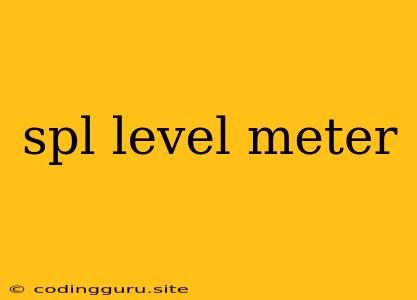Understanding SPL Level Meters: A Comprehensive Guide
A SPL level meter is an essential tool for anyone working with sound, whether it's in a studio, on a live stage, or in a noise-sensitive environment. But what exactly is an SPL level meter, and what makes it so important?
What is an SPL Level Meter?
An SPL level meter, also known as a sound pressure level meter, is a device that measures the sound pressure level (SPL) of a sound source. SPL is measured in decibels (dB), which is a logarithmic unit that represents the ratio of sound pressure to a reference pressure.
Why is an SPL Level Meter Important?
Sound pressure level can be a crucial factor in many situations. Here are a few reasons why understanding and measuring SPL is important:
- Protecting your hearing: Excessive noise levels can damage your hearing. An SPL meter can help you identify and avoid potentially harmful sound levels.
- Ensuring audio quality: In a studio or live sound setting, SPL meters help you ensure that your audio equipment is operating within safe and optimal levels.
- Complying with regulations: Many jurisdictions have noise ordinances that restrict the maximum sound levels allowed in certain areas.
- Understanding the acoustical environment: SPL meters are used to measure and analyze the acoustical characteristics of a space, which can be useful for optimizing the sound quality and reducing noise levels.
Types of SPL Level Meters:
There are two main types of SPL level meters:
- Analog SPL Meters: These meters use a needle to display the measured SPL level. They are generally less expensive than digital meters, but may be less accurate.
- Digital SPL Meters: These meters use a digital display to show the measured SPL level, often with more precise readings and features like data logging and frequency analysis.
Features of SPL Level Meters:
Modern SPL meters come equipped with a range of features that make them versatile and user-friendly. Some of the most common features include:
- Weighting: SPL meters can use various weighting curves to adjust the measurement to better reflect human perception of sound. Common weighting curves include A-weighting (mimicking human hearing at low levels) and C-weighting (closer to the sound pressure level itself).
- Frequency Response: The frequency response of an SPL meter determines its ability to accurately measure different frequencies.
- Range: The range of an SPL meter refers to the highest and lowest SPL levels it can measure.
- Data Logging: Some SPL meters can record SPL readings over time, allowing you to analyze sound levels and identify patterns.
Using an SPL Level Meter:
To use an SPL level meter effectively, follow these basic steps:
- Select the appropriate weighting curve: Choose the weighting curve that best suits your application. A-weighting is often used for general noise measurements, while C-weighting is used for high-level sound measurements.
- Position the meter: Place the microphone of the SPL meter at the desired measurement point. For accurate results, the microphone should be positioned as close as possible to the sound source.
- Take readings: Hold the SPL meter steady and observe the readings on the display.
- Interpret the readings: Use the readings to determine the SPL level and make informed decisions based on your needs.
Calibration:
To ensure that your SPL meter is providing accurate readings, it's important to calibrate it regularly. Calibration involves comparing the meter's readings to a known standard.
Applications of SPL Level Meters:
SPL level meters have a wide range of applications, including:
- Noise control and abatement: Measuring noise levels in workplaces, neighborhoods, and other environments to identify and reduce excessive noise.
- Environmental monitoring: Tracking sound levels in natural environments to monitor pollution and wildlife activity.
- Audio production: Ensuring that audio equipment is operating at safe and optimal levels in studios, live sound settings, and for recording.
- Concert sound reinforcement: Optimizing the sound levels at live concerts to ensure a balanced and enjoyable experience for the audience.
- Construction and machinery: Monitoring noise levels from construction projects and industrial machinery to comply with regulations and minimize noise pollution.
Conclusion:
SPL level meters are invaluable tools for anyone who needs to measure and analyze sound levels. By understanding the principles of SPL measurement and using a SPL meter effectively, you can protect your hearing, ensure optimal audio quality, and comply with relevant regulations.
